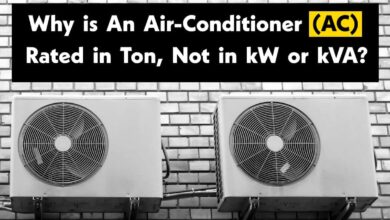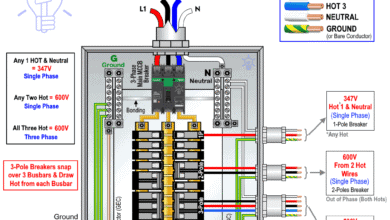Difference Between Shunt Capacitors and Shunt Reactors
What is the Difference Between Shunt Reactor and Shunt Capacitor?
There are several devices used in an electrical power system to improve the power factor and its efficiency. A shunt capacitor and a shunt reactor are two different devices used to improve the performance of an electrical grid. There are several other differences between them that we will discuss in this article.
First, we will discuss their basics before going into the list of differences between shunt capacitors and shunt reactors.
Shunt Capacitors
A stunt capacitor is a capacitor or group of capacitors called a capacitor bank connected in parallel to the system. It is used to improve the power factor and efficiency of the power system. The capacitor is used to compensate for the inductive load thus improving the power factor of a system.
As we know, most loads connected in an electrical power system are inductive in nature such as electrical machines, transformers, relays, etc. They all contribute inductive reactance to the power system including the inductance of the power lines. As we know inductance causes lag in the current. Therefore, the current in the power system lags behind the voltage. The increase in the lagging angle decreases the power factor of the system. Due to this lagging power factor, the load draws more current from the source for the same power rating. This increase in the current causes extra line losses in the form of heat.
The capacitance of the capacitor causes to lead the current from the voltage. Therefore it can be used to cancel the inductive reactance in a power system. Multiple units of capacitors known as capacitor bank is connected in parallel to improve power factor known as shunt capacitors.
Shunt Reactor
A shunt reactor is a device used in a power system to improve its efficiency by stabilizing the voltage during the load variation. It is used for compensating the capacitive reactive power in a power transmission line. It is generally used for 400kV or above transmission lines.
It is made of a single winding either directly connected to the power line or the tertiary winding of a three-phase transformer. It absorbs the reactive power from the power lines to increase its efficiency.
Differences between Shunt Capacitor and Shunt Reactor
The following table shows the comparisons between shunt reactors and shunt capacitors.
| Shunt Capacitor | Shunt Reactor |
| It is a single or multiple unit of capacitors connected in parallel with a power system to improve its power factor. | It is a device made of single winding connected with power transmission lines to stabilize the voltage during load variation. |
| It provides reactive power to the electrical system | It absorbs the reactive power from the system |
| It introduces capacitive reactance into the system. | It introduces inductive reactance into the system. |
| It primarily improves the power factor | It stabilizes the voltage. |
| It directly improves the power factor of a power system. | It indirectly affects the power factor of the system |
| It can cause an increase in the voltage during light load conditions. | It can cause a slight decrease in voltage |
| It is directly connected to the power lines | It can be directly connected to the power line or the tertiary winding of a 3-phase transformer. |
| It may amplify the harmonics in a system | It eliminates the harmonics in a system. |
| It is used in industrial and commercial building power systems to improve the power factor. | It is used for voltage stabilization in high-voltage power transmission lines. |
Comparison Between Shunt Capacitors & Shunt Reactors
Function
- The shunt capacitor is used to provide reactive power to the electrical system which is absorbed by the inductive load in the system such as machines and transformers etc. It leads to power factor improvement and system efficiency.
- The shunt reactor is used to absorb and control the flow of reactive power in the system to improve its efficiency. It helps in controlling the voltage levels and improving system stability. It reduces voltage surges and transients.
Power Factor Correction
- Shunt capacitor directly affects and improves the power factor by providing reactive power.
- The Shunt reactor indirectly improves the power factor by stabilizing the voltage in the power line.
Connection
- The shunt capacitor is directly connected in parallel with the power line.
- The shunt reactor is either connected directly or with the tertiary of a 3-phase transformer.
Voltage
- The shunt capacitor can cause an increase in the voltage during light load conditions in a power system.
- The shunt reactor can cause a slight decrease in voltage due to the nature of inductive reactance.
Harmonics
- Shunt capacitors can cause resonant conditions that can amplify the harmonics in the voltage.
- The shunt reactor can dampen and eliminate the harmonics in an electrical power system.
Applications
- Shunt capacitor finds their applications in the improvement of power factor in different kinds of power systems in industrial and commercial buildings.
- While the shunt reactor is primarily used in high-voltage transmission lines for voltage stabilization.
We can conclude that both the shunt capacitor and shunt reactor are used to improve the efficiency of an electrical power system. Where the shunt capacitor improves the power factor and the shunt reactor stabilizes voltage and reduces harmonics in a power system.
Related posts about the comparison and differences between different electrical and electronic components and devices.
- Comparison Between Overhead & Underground Transmission Systems
- Difference between AC and DC Transmission System & Power Lines
- Differences Between HVAC and HVDC – Power Transmission
- Advantages of HVDC over HVAC Power Transmission
- Advantages & Disadvantages of 50 Hz and 60 Hz Frequency Power Supply
- Difference Between 50 Hz and 60 Hz Frequency System
- Difference Between 120V and 240V/230V AC Power Supply
- Difference Between Porcelain and Glass Insulators
- Stranded Wire vs Solid Wire. Which One is Best and Why?
- Difference Between Current Transformer & Potential Transformer
- Difference Between Single Phase and Three Phase Power Supply
- Advantages of Three Phase System Over Single Phase System
- Difference Between Active and Reactive Power – kW vs KVA
- Difference Between Grounding, Earthing and Bonding
- What is the Difference Between Neutral, Ground and Earth?
- Difference Between Power Transformers and Distribution Transformers?
- Difference Between Single Phase and Three Phase Transformer
- Difference between Inverter & UPS – Uninterruptible Power Supply







